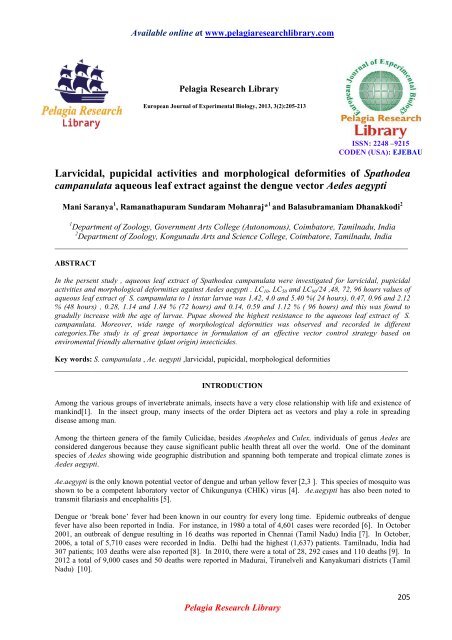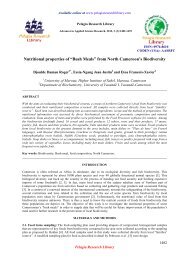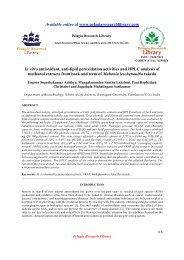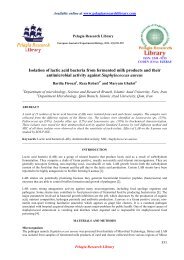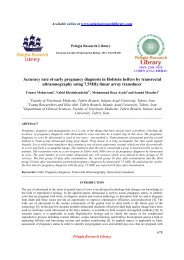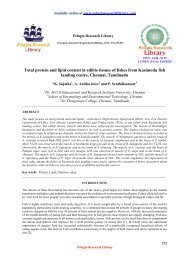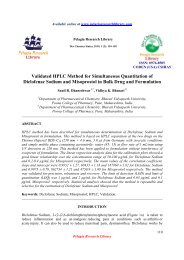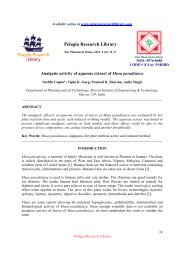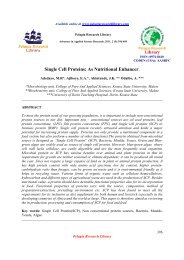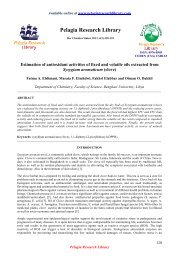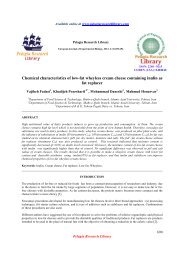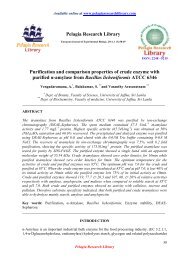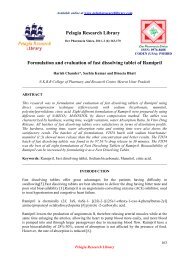Larvicidal, pupicidal activities and morphological deformities of ...
Larvicidal, pupicidal activities and morphological deformities of ...
Larvicidal, pupicidal activities and morphological deformities of ...
Create successful ePaper yourself
Turn your PDF publications into a flip-book with our unique Google optimized e-Paper software.
Available online at<br />
www.pelagiaresearchlibrary.com<br />
Pelagia Research Library<br />
European Journal <strong>of</strong> Experimental Biology, 2013, 3(2):205-213<br />
ISSN: 2248 –9215<br />
CODEN (USA): EJEBAU<br />
<strong>Larvicidal</strong>, <strong>pupicidal</strong> <strong>activities</strong> <strong>and</strong> <strong>morphological</strong> <strong>deformities</strong> <strong>of</strong> Spathodea<br />
campanulata aqueous leaf extract against the dengue vector Aedes aegypti<br />
Mani Saranya 1 , Ramanathapuram Sundaram Mohanraj* 1 <strong>and</strong> Balasubramaniam Dhanakkodi 2<br />
1<br />
Department <strong>of</strong> Zoology, Government Arts College (Autonomous), Coimbatore, Tamilnadu, India<br />
2 Department <strong>of</strong> Zoology, Kongunadu Arts <strong>and</strong> Science College, Coimbatore, Tamilnadu, India<br />
___ __________________________________________________________________________________________<br />
ABSTRACT<br />
In the persent study , aqueous leaf extract <strong>of</strong> Spathodea campanulata were investigated for larvicidal, <strong>pupicidal</strong><br />
<strong>activities</strong> <strong>and</strong> <strong>morphological</strong> <strong>deformities</strong> against Aedes aegypti . LC10, LC50 <strong>and</strong> LC90/24 ,48, 72, 96 hours values <strong>of</strong><br />
aqueous leaf extract <strong>of</strong> S. campanulata to 1 instar larvae was 1.42, 4.0 <strong>and</strong> 5.40 %( 24 hours), 0.47, 0.96 <strong>and</strong> 2.12<br />
% (48 hours) , 0.28, 1.14 <strong>and</strong> 1.84 % (72 hours) <strong>and</strong> 0.14, 0.59 <strong>and</strong> 1.12 % ( 96 hours) <strong>and</strong> this was found to<br />
gradully increase with the age <strong>of</strong> larvae. Pupae showed the highest resistance to the aqueous leaf extract <strong>of</strong> S.<br />
campanulata. Moreover, wide range <strong>of</strong> <strong>morphological</strong> <strong>deformities</strong> was observed <strong>and</strong> recorded in different<br />
categories.The study is <strong>of</strong> great importance in formulation <strong>of</strong> an effective vector control strategy based on<br />
enviromental friendly alternative (plant origin) insecticides.<br />
Key words: S. campanulata , Ae. aegypti ,larvicidal, <strong>pupicidal</strong>, <strong>morphological</strong> <strong>deformities</strong><br />
________________ _____________________________________________________________________________<br />
INTRODUCTION<br />
Among the various groups <strong>of</strong> invertebrate animals, insects have a very close relationship with life <strong>and</strong> existence <strong>of</strong><br />
mankind[1]. In the insect group, many insects <strong>of</strong> the order Diptera act as vectors <strong>and</strong> play a role in spreading<br />
disease among man.<br />
Among the thirteen genera <strong>of</strong> the family Culicidae, besides Anopheles <strong>and</strong> Culex, individuals <strong>of</strong> genus Aedes are<br />
considered dangerous because they cause significant public health threat all over the world. One <strong>of</strong> the dominant<br />
species <strong>of</strong> Aedes showing wide geographic distribution <strong>and</strong> spanning both temperate <strong>and</strong> tropical climate zones is<br />
Aedes aegypti.<br />
Ae.aegypti is the only known potential vector <strong>of</strong> dengue <strong>and</strong> urban yellow fever [2,3 ]. This species <strong>of</strong> mosquito was<br />
shown to be a competent laboratory vector <strong>of</strong> Chikungunya (CHIK) virus [4]. Ae.aegypti has also been noted to<br />
transmit filariasis <strong>and</strong> encephalitis [5].<br />
Dengue or ‘break bone’ fever had been known in our country for every long time. Epidemic outbreaks <strong>of</strong> dengue<br />
fever have also been reported in India. For instance, in 1980 a total <strong>of</strong> 4,601 cases were recorded [6]. In October<br />
2001, an outbreak <strong>of</strong> dengue resulting in 16 deaths was reported in Chennai (Tamil Nadu) India [7]. In October,<br />
2006, a total <strong>of</strong> 5,710 cases were recorded in India. Delhi had the highest (1,637) patients. Tamilnadu, India had<br />
307 patients; 103 deaths were also reported [8]. In 2010, there were a total <strong>of</strong> 28, 292 cases <strong>and</strong> 110 deaths [9]. In<br />
2012 a total <strong>of</strong> 9,000 cases <strong>and</strong> 50 deaths were reported in Madurai, Tirunelveli <strong>and</strong> Kanyakumari districts (Tamil<br />
Nadu) [10].<br />
Pelagia Research Library<br />
205
Ramanathapuram S Mohanraj et al Euro. J. Exp. Bio., 2013, 3(2):205-213<br />
_____________________________________________________________________________<br />
Chikungunya, a febrile disease is caused by Chikungunya virus which is transmitted by Ae.aegypti. There was an<br />
outbreak <strong>of</strong> this disease in Calcutta in 1963-1964 <strong>and</strong> another in Madras (Chennai) in 1965 which gave rise to<br />
3,00,000 cases in Madras city alone [5 ]. According to Central Health Secretary <strong>of</strong> India, in 2006, 13 lakh people<br />
affected by this disease. In Tamil Nadu alone 63,000 persons were affected by this disease [8]. These diseases<br />
devastate Indian economy every year [11].<br />
At present, no effective vaccine is available for dengue; therefore, the only way <strong>of</strong> reducing the incidence <strong>of</strong> this<br />
disease is mosquito control [ 12]. The control methods should aim at the weakest link <strong>of</strong> the life cycle <strong>of</strong> the<br />
mosquito, which is the larval stage. During the immature stage, mosquitoes are relatively immobile, remaining<br />
more concentrated than they are in the adult stage [13].<br />
Many control strategies for mosquitoes have been suggested since the ancient times.<br />
Over <strong>and</strong> injudicious use <strong>of</strong> synthetic insecticides in vector control has resulted in environment hazards through<br />
persistence <strong>and</strong> accumulation <strong>of</strong> non–biodegradable toxic components in the ecosystem, development <strong>of</strong> insecticide<br />
resistance among mosquito species, biological magnification in the food chain <strong>and</strong> toxic effects on human health <strong>and</strong><br />
non–target organisms [14,15].<br />
This has necessitated the need for the search <strong>and</strong> development <strong>of</strong> environmentally safer, low cost, indigenous<br />
methods for vector control.<br />
During the last decade, various studies on natural plant products against mosquito vectors indicate them as possible<br />
alternatives to synthetic chemical insecticides [16,17]. More then 2000 plants species have been known to produce<br />
chemical factors <strong>and</strong> metabolites <strong>of</strong> value in the pest control programes [18] <strong>and</strong> among these plants, products <strong>of</strong><br />
some 344 species have been reported to have a variety <strong>of</strong> <strong>activities</strong> against mosquitoes [19].<br />
Botanical insecticides also have potential uses such as larvicidal, ovicidal, oviposition deterrence, growth <strong>and</strong><br />
reproduction inhibitors, repellents, growth regulation, fecundity suppression, male sterility [20,21]. Some <strong>of</strong> the<br />
plant leaf extract tested for their diverse insecticidal properties on the medically important mosquitoes are: aqueous<br />
extracts <strong>of</strong> Senna didymobotrya leaves [22]; ethanolic extract <strong>of</strong> Centella asiatica leaves [23] ; aqueous extracts <strong>of</strong><br />
Gymnema sylvestre <strong>and</strong> Eclipta prostrata leaves [24]; methanolic extracts <strong>of</strong> Azadirachta excelsa, Cleome<br />
glaucescens <strong>and</strong> Ricinus communis leaves [25]; aqueous leaves extract <strong>of</strong> Calotropis procera [20]; aqueous extract<br />
<strong>of</strong> Gymnema sylvestre, Nerium indicum <strong>and</strong> Datura metal leaves [26]; methanol leaf extract <strong>of</strong> Ervatamia coronaria<br />
<strong>and</strong> Caesalpinia pulcherrima [27]; methanolic extracts <strong>of</strong> Acalypha alnifolia leaves [28]; aqueous leaf extract <strong>of</strong><br />
Lantana camara [29].<br />
It could be as certained from the literature survey that there was no information available on the larvicidal,<br />
<strong>pupicidal</strong>, <strong>deformities</strong> effects <strong>of</strong> the aqueous leaf extract <strong>of</strong> the S. campanulata.<br />
The present study was therefore carried out to evaluate mosquitocidal properties <strong>of</strong> S. campanulata aqueous leaf<br />
extracts against the vector mosquito, Ae. aegypti.<br />
Spathodea is a monotypic genus in the flowering plant family Bignoniaceae. It contains the single species,<br />
Spathodea campanulata, which is commonly known as the Fountain Tree, African Tulip Tree, Flame-<strong>of</strong> –the forest,<br />
Rudra palash, Pichkari or N<strong>and</strong>i Flame in different parts <strong>of</strong> the world. It is a tree that grows between 7-25 m (23-<br />
82ft) tall <strong>and</strong> native to tropical Africa. It is commonly planted as a street tree in south Tamil Nadu. The tree is<br />
considered evergreen but it sheds leaves in dry summers <strong>and</strong> hence it is a dry season deciduous tree. S. campanulata<br />
commonly employed to control epilepsy. The leaves have furnished Spathodol, caffeic acid <strong>and</strong> other phenolic<br />
acids <strong>and</strong> flavonoids.<br />
MATERIALS AND METHODS<br />
Colonization <strong>of</strong> Aedes aegypti<br />
Collection <strong>of</strong> eggs<br />
The eggs <strong>of</strong> Ae. aegypti were collected from National Institute for Communicable Disease (NICD), Mettupalayam,<br />
Coimbatore, Tamil Nadu, India without exposure to any insecticide. The eggs were then brought to the laboratory<br />
<strong>and</strong> transferred to enamel trays containing water <strong>and</strong> kept for larval hatching. They were hatched <strong>and</strong> reared <strong>and</strong><br />
have been still maintained for many generations in the laboratory. The eggs <strong>and</strong> larvae obtained from this stock<br />
were used for different experiments.<br />
Pelagia Research Library<br />
206
Ramanathapuram S Mohanraj et al Euro. J. Exp. Bio., 2013, 3(2):205-213<br />
_____________________________________________________________________________<br />
Maintenance <strong>of</strong> larvae<br />
The larvae were reared in plastic cups. They were daily provided with commercial fish food ad libitum [30]. Water<br />
was changed alternate days. The breeding medium was regularly checked <strong>and</strong> dead larvae were removed at sight.<br />
The normal cultures as well as breeding cups used for any experimental purpose during the present study were kept<br />
closed with muslin cloth for preventing contamination through foreign mosquitoes.<br />
Maintenance <strong>of</strong> pupae <strong>and</strong> adult<br />
The pupae were collected from culture trays <strong>and</strong> were transferred to glass beakers containing water with help <strong>of</strong> a<br />
sucker. The pupae containing glass beaker were kept in side mosquito cage for adult emergence. The cage was<br />
made up <strong>of</strong> steel frame wrapped with mosquito netting. The cage had a provision (a hole) for h<strong>and</strong>ling <strong>of</strong> materials<br />
<strong>and</strong> animals placed inside. The hole was guarded with a sleeve which was useful to close suddenly after being used.<br />
Blood feeding <strong>of</strong> adult Ae.aegypti <strong>and</strong> egg laying<br />
The females were fed by h<strong>and</strong> every alternate day. Feeding mosquitoes on human arm for experimental purposes<br />
was suggested by [31,32].<br />
Both females <strong>and</strong> males were provided with 10% glucose solution on cotton wicks [33]. The cotton was always<br />
kept moist with the solution <strong>and</strong> changed every day.<br />
An egg trap (cup) lined with filter paper containing pure water was always placed at a corner <strong>of</strong> the cage. This<br />
arrangement made the collection <strong>of</strong> eggs easier.<br />
Collection <strong>of</strong> plant materials<br />
S. campanulata P. Beauv. (Family : Bignoniaceae) leaves were collected from Government Arts college campus,<br />
Coimbatore, Southern India. The identification <strong>of</strong> the plants was authentified at BSI (Botanical Survey <strong>of</strong> India),<br />
Coimbatore.<br />
Preparation <strong>of</strong> plant extract<br />
The fresh leaves <strong>of</strong> the plant S. campanulata were collected in our college campus area. Then the leaves brought to<br />
the laboratory. The plant leaves were observed carefully for any kind <strong>of</strong> diseases or infection <strong>and</strong> if found any, those<br />
parts were separated <strong>and</strong> not used for the experiment. The selected leaves washed with distilled water in order to<br />
clean dust or any particle stuck to them. Then the leaves kept for drying under shade at room temperature (27± 2 o C)<br />
for about 2 weeks till they dried completely. The leaves were finely powdered using electric blender. Different<br />
concentrations <strong>of</strong> the leaf extract was prepared taking a particular amount <strong>of</strong> leaf powder in glass beaker containing<br />
a known quantity <strong>of</strong> unchlorinated filtered tap water. The solution was allowed to st<strong>and</strong> for 72 hrs <strong>and</strong> the<br />
suspension was filtered through Whatman No.1 filter paper. For instance, 2g powder mixed in 200 ml <strong>of</strong> water for<br />
getting experimental medium <strong>of</strong> 1%. This solution was used for experiments.<br />
Bioassay test<br />
Bioassay tests were carried out for testing the efficacy <strong>of</strong> aqueous leaf extracts <strong>of</strong> S.campanulata on Ae.aegypti at<br />
different stages <strong>of</strong> development viz I, II, III <strong>and</strong> IV instars <strong>and</strong> pupae. Instructions <strong>of</strong> WHO (1960) as detailed by<br />
[34] for conducting bioassay experiment with mosquito larvae were carefully followed.<br />
Different concentrations <strong>of</strong> the test compound were prepared using unchlorinated filtered tap water as described<br />
earlier. Clean plastic cubs <strong>of</strong> 500 ml capacity were used as test containers. Batches <strong>of</strong> 20 larvae were exposed to<br />
200 ml <strong>of</strong> particular concentration <strong>of</strong> test solution. The larvae <strong>of</strong> either I, II, III, IV instar stage <strong>and</strong> pupae were<br />
collected with an eye dropper placed onto filter paper strips <strong>and</strong> immediately transferred to test cup containing test<br />
solution according to [35].<br />
Mortality rates <strong>of</strong> larvae were recorded after 24, 48, 72 <strong>and</strong> 96 hours. Five or more concentrations <strong>of</strong> a test<br />
compound giving between 0 <strong>and</strong> 100% mortality for larvae at different instar stages were tested. Parallel controls<br />
were maintained. Two replicates were done at each concentration. In recording the percentage moralities for each<br />
concentration, the moribund <strong>and</strong> dead larvae in both replicates were combined.<br />
It was described that dead larvae are those that cannot be induced to move when they are probed with a needle in the<br />
siphon or the cervical region, moribund larvae are those incapable <strong>of</strong> rising to the surface [34].<br />
The values <strong>of</strong> LC10, LC50 <strong>and</strong> LC90 <strong>and</strong> their 95% confidence limit <strong>of</strong> upper confidence limit (UCL) <strong>and</strong> lower<br />
confidence limit (LCL), regression were calculated using probit analysis [36]. The SPSS 17.0 (Statistical Package <strong>of</strong><br />
Social Sciences) used for statistical analysis.<br />
Pelagia Research Library<br />
207
Ramanathapuram S Mohanraj et al Euro. J. Exp. Bio., 2013, 3(2):205-213<br />
_____________________________________________________________________________<br />
Record <strong>of</strong> <strong>deformities</strong><br />
During the course <strong>of</strong> lethal experiments, the <strong>morphological</strong> features <strong>of</strong> larvae at different stages, pupa <strong>and</strong> adults<br />
from treated <strong>and</strong> control media were compared. Any notable difference in appearance between treated <strong>and</strong> control<br />
was recorded as deformity. The <strong>deformities</strong> were designated according to their similarity to those previously<br />
exhibited by [37- 42].<br />
RESULTS AND DISCUSSION<br />
Toxicity <strong>of</strong> aqueous leaf extract <strong>of</strong> S. campanulata to the developmental stages <strong>of</strong> Ae. aegypti<br />
Bioassay tests were conducted to find out the toxicity <strong>of</strong> aqueous extract to I, II, III, IV instars <strong>and</strong> pupae <strong>of</strong> the<br />
mosquitoes <strong>of</strong> Ae. aegypti. The data were subjected to Finney’s method <strong>of</strong> probit analysis. The results expressed in<br />
terms <strong>of</strong> LC10, LC50 <strong>and</strong> LC90 / 24, 48, 72, 96 hours.<br />
LC10, LC50 <strong>and</strong> LC90 / 24, 48, 72, 96 hours values <strong>of</strong> aqueous leaf extract <strong>of</strong> Spathodea campanulata to I instar<br />
larvae was 1.42, 4.0 <strong>and</strong> 5.40% (24 hrs), 0.47, 0.96, <strong>and</strong> 2.12% (48 hrs), 0.28, 1.14 <strong>and</strong> 1.84% (72 hrs) <strong>and</strong> 0.14,<br />
0.59 <strong>and</strong> 1.12% (96 hrs) <strong>and</strong> this was found to gradually increase with the age <strong>of</strong> larvae. Pupae showed the highest<br />
resistance to the aqueous leaf extract <strong>of</strong> Spathodea campanulata as evident from the relatively higher LC10, LC50 <strong>and</strong><br />
LC90/ 24, 48, 72, <strong>and</strong> 96 hours values 19.72, 21.0 <strong>and</strong> 23.81% (24 hrs) , 16.35, 18.85 <strong>and</strong> 21.0% (48 hrs), 13.64,<br />
16.10 <strong>and</strong> 17.22% (72 hrs) <strong>and</strong> 11.67, 12.93 <strong>and</strong> 14.58% (96 hrs) (Tables 1- 3).<br />
Deformities<br />
Visible <strong>morphological</strong> <strong>deformities</strong> occurred among the larvae exposed to lethal concentrations <strong>of</strong> aqueous leaf<br />
extract <strong>of</strong> Spathodea campanulata. Larvae <strong>and</strong> pupae survived through treatment frequently showed a variety <strong>of</strong><br />
changes viz., dechitinized larva with damaged digestive tract (Plate 1a); exuvia <strong>of</strong> the proceding instar attached to<br />
the dead larvae (Plate 1b); death <strong>of</strong> larval stage with no intiation <strong>of</strong> pupation (Plate 1c), malformations like<br />
demelanized pupa with straight abdomen (Plate 2a); dwarf pupa with retarded abdomen (Plate 2b); Pupa with some<br />
melanization (brown pupa) (Plate 2c); <strong>and</strong> partly emerged adult with attached pupal case (Plate3).<br />
The findings agree with some <strong>of</strong> the previous reports.<br />
The leaf extract <strong>of</strong> Ocimum canum against Ae. aegypti showed LC50 values for 2 nd , 3 rd <strong>and</strong> 4 th instar larvae at 77.82,<br />
229.08 <strong>and</strong> 331.13 ppm respectively [43]; the leaf extract <strong>of</strong> Acalypha indica with different solvents viz, benzene,<br />
chlor<strong>of</strong>orm, ethyl acetate <strong>and</strong> methanol was tested for larvicidal activity against An. stephensi <strong>and</strong> the LC50<br />
values/24hrs were observed to be 19.25, 27.76, 23.26 <strong>and</strong> 15.03ppm respectively [44]; the leaf extract <strong>of</strong> Cassia<br />
fistula with different solvents viz, methanol, benzene, acetone was for the larvicidal activity against Ae. aegypti <strong>and</strong><br />
the 24hrs LC50 <strong>of</strong> the extract against Ae. aegypti were 10.69, 18.27 <strong>and</strong> 23.95 mg/l respectively [45]; larvicidal<br />
efficacy <strong>of</strong> leaf extract <strong>of</strong> Pavonia zeylanica <strong>and</strong> Acacia ferruginea (Malvaceae) were tested against the late third –<br />
instar larvae <strong>of</strong> Cx. quinquefaciatus, <strong>and</strong> their LC50 values were 2214.7 <strong>and</strong> 5362.6 ppm respectively [46]; ethyl<br />
acetate, petroleum ether <strong>and</strong> methanol leaf extract <strong>of</strong> Citrullus colocynthis <strong>and</strong> Cucurbita maxima showed LC50<br />
values <strong>of</strong> 47.58, 66.92 <strong>and</strong> 118.74 ppm <strong>and</strong> 75.91,117.73 <strong>and</strong> 171.64 ppm respectively against Cx, quinquefasciatus<br />
larvae [47]; the petroleum ether extract <strong>of</strong> the leaves <strong>of</strong> Vitex negundo were evaluated for larvicidal activity against<br />
larval stage <strong>of</strong> Cx. tritaeniorhynchus in the laboratory with LC50 <strong>and</strong> LC90 values <strong>of</strong> 2.4883 <strong>and</strong> 5.1883 mg/l,<br />
respectively [48]; 24 hrs exposure to early fourth instar <strong>of</strong> Ae. aegypti with hexane extract <strong>of</strong> the leaves <strong>of</strong> Citrus<br />
sinensis resulted in 50% mortality at 446.84 ppm [49]; 1 mg/ml the ethanol extract <strong>of</strong> the leaves <strong>of</strong> Lantana camara<br />
caused 84% larval mortality while the methanol extract showed 48% mortality in the fourth instar larvae <strong>of</strong> Ae.<br />
aegypti [50]; methanol extract <strong>of</strong> the leaves <strong>of</strong> Achyranthes aspera caused 50% mortality <strong>of</strong> Ae. aegypti larvae at<br />
409 ppm [51]; the hexane extract <strong>of</strong> Abutlion indicum leaves caused 100% mortality at 1000 ppm with LC50 value <strong>of</strong><br />
261.31 ppm against the larvae <strong>of</strong> Ae. aegypti at 24 hrs [52]; the LC50 values <strong>of</strong> methanol, benzene, acetone leaf<br />
extracts <strong>of</strong> Pemphis acidula against Cx. quinquefasciatus <strong>and</strong> Ae. aegypti were 10.81 ppm, 41.07 ppm, 53.22 ppm<br />
<strong>and</strong> 22.10 ppm, 43.99 ppm, 57.66 ppm respectively [53]; the LC50 values <strong>of</strong> Ficus benghalensis leaf extract against<br />
early second, third <strong>and</strong> fourth larvae <strong>of</strong> Cx. quinquefasciatus, Ae. aegypti <strong>and</strong> An. stephensi were 41.43, 58.21 <strong>and</strong><br />
74.32 ppm,56.54, 70.29 <strong>and</strong> 80.85 ppm <strong>and</strong> 60.44, 76.41 <strong>and</strong> 89.55 ppm respectively [54]; the LC50 <strong>and</strong> LC90 values<br />
<strong>of</strong> crude methanol extract <strong>of</strong> leaves <strong>of</strong> Ervatamia coronaria on Cx. quinquefasciatus, Ae. aegypti <strong>and</strong> An. stephensi<br />
larvae in 24hrs <strong>and</strong> the results were 72.41 <strong>and</strong> 65.67 mg/l, 62.08 <strong>and</strong> 136.55 mg/l, 127.24 <strong>and</strong> 120.86 mg/l<br />
respectively [55]; the larvicidal efficacy was determined <strong>of</strong> benzene, hexane, ethyl acetate, methanol <strong>and</strong><br />
chlor<strong>of</strong>orm leaf extract <strong>of</strong> Cardiospermum halicacabum against Cx. quinquefasciatus <strong>and</strong> Ae. aegypti, the LC50<br />
values were 174.24, 193.31, 183.36, 150.44, 154.95 ppm <strong>and</strong> 182.51, 200.02, 192.31, 156.80, 164.54 ppm<br />
respectively [56]; the larvicidal activity <strong>of</strong> hexane, acetone <strong>and</strong> methanol extracts <strong>of</strong> the leaves <strong>of</strong> Toddalia asiatica<br />
against Ae. aegypti <strong>and</strong> Cx. quinquefasciatus was investigated <strong>and</strong> the LC50 values were 133.80, 177.20 <strong>and</strong> 79.48<br />
<strong>and</strong> 164.53, 175.28 <strong>and</strong> 87.87 ppm [57]; acetone leaf extract <strong>of</strong> Biophytum sensitivum displayed the highest<br />
Pelagia Research Library<br />
208
Ramanathapuram S Mohanraj et al Euro. J. Exp. Bio., 2013, 3(2):205-213<br />
_____________________________________________________________________________<br />
larvicidal <strong>and</strong> <strong>pupicidal</strong> with LC50 values <strong>of</strong> 21.79 <strong>and</strong> 13.05 mg/ ml against Ae. aegypti [58]; methanolic leaf<br />
extract <strong>of</strong> Spathodea campanulata were found most effective with LC50 <strong>and</strong> LC90 value <strong>of</strong> 4.026, 4.207, 4.699, 4.852<br />
<strong>and</strong> 4.861 if I, II, III, IV <strong>and</strong> pupa <strong>of</strong> An. stephensi respectively [59].<br />
The S. campanulata leaves have furnished Spathodol, caffeic acid, phenolic acids <strong>and</strong> flavonoids [60- 62]. These<br />
compounds may jointly (or) independently contribute to larvicidal activity against Ae. aegypti. The phytochemicals<br />
interfered with proper functioning <strong>of</strong> mitochondria more specifically at the porton transforming sites [63] <strong>and</strong><br />
phytochemicals primarily effect the midgut epithelium <strong>and</strong> secondarily affect the gastric caeca <strong>and</strong> the malpighian<br />
tubules in mosquito larvae [64,65]. The death <strong>of</strong> treated larvae may be due to the inability <strong>of</strong> the moulting bodies to<br />
swallow sufficient volume <strong>of</strong> air to split the old cuticle <strong>and</strong> exp<strong>and</strong> the new one during ecdysis or to a<br />
metamorphosis inhibiting effect <strong>of</strong> the plant extract which is possibly based on the disturbance <strong>of</strong> the hormonal<br />
regulation [66].<br />
In the present study, the Ae. aegypti larvae reared in lethal dose <strong>of</strong> aqueous leaf extracts <strong>of</strong> S. campanulata, in<br />
addition to changes in the indices <strong>of</strong> development, also exhibited, in common, a variety <strong>of</strong> metamorphic aberrations.<br />
Some <strong>of</strong> the visible malformations were dechitinized larva with damaged digestive tract, exuvia <strong>of</strong> the proceding<br />
instar attached the dead larvae, death occurred during the larval stage with no initiation <strong>of</strong> pupation, demelanized<br />
pupa with straight abdomen, dwarf pupa with retarded abdomen, pupa with some melanization (brown pupa) <strong>and</strong><br />
partly emerged adult with attached pupal case. Similar <strong>deformities</strong> were found to occur during the development <strong>of</strong><br />
Ae. aegypti, Cx. quinquefasciatus <strong>and</strong> An. stephensi in media treated with hexane, diethyl ether, dichloromethane<br />
<strong>and</strong> ethyl acetate extracts <strong>of</strong> Murraya koenigii leaf [42]; early fourth instar larvae <strong>of</strong> Ae. aegypti exposed to acetone<br />
leaf extracts <strong>of</strong> Saraca indica <strong>and</strong> Cassia fistula showed, a variety <strong>of</strong> morhogenetic effects[67]; ethanolic, acetone<br />
<strong>and</strong> petroleum ether extracts <strong>of</strong> leaves from Cupressus semprevirens were tested against 3 rd instar larvae <strong>of</strong> Cx.<br />
pipiens, various degrees <strong>of</strong> morphogenic abnormalities were observed in immature <strong>and</strong> adult stages [68]; the hexane,<br />
diethyl ether, dichloromethane <strong>and</strong> ethyl acetate extracts <strong>of</strong> Abutilon indicum leaf were evaluated for their pupal<br />
<strong>deformities</strong> against Ae. aegypti, Cx. quinquefasciatus <strong>and</strong> An. stephensi [52]; Phytoextracts affect larval<br />
morphology, resulting in pigmentation <strong>and</strong> alternations in head <strong>and</strong> abdomen shape [69].<br />
These morphogenetic abnormalities are commonly caused by botanical extracts <strong>and</strong> are atributed to result from<br />
disturbance to growth regulating hormones [70].<br />
The study concludes that this leaf extract has potent larvicidal, <strong>pupicidal</strong> property along with morphogenetic effects.<br />
So this extract can be used as a solution for mosquito problem in the developing countries without damaging the<br />
environment.<br />
Table.1 Log probit analysis <strong>and</strong> regression analysis <strong>of</strong> Spathodea campanulata aqueous leaf extract against different larval instars <strong>and</strong><br />
pupae <strong>of</strong> Aedes aegypti.<br />
Larval instars Period <strong>of</strong> bioassay(h) LC10 (%) Confidence interval(95%) LL UL<br />
Regression equation Regression value<br />
24<br />
1.42 1.06 1.87<br />
y=43x-54<br />
0.533<br />
First<br />
48<br />
72<br />
0.47<br />
0.28<br />
0.28<br />
0.12<br />
0.52<br />
0.33<br />
y=230x-81<br />
y=215x-32.5<br />
0.445<br />
0.650<br />
96<br />
0.14 0.093 0.197 y=289x-29.06<br />
0.768<br />
24<br />
3.97 3.14 4.83 y=20.5x-68.5<br />
0.511<br />
Second<br />
48<br />
72<br />
0.94<br />
0.38<br />
0.45<br />
0.26<br />
1.21<br />
0.43<br />
y=205x-173<br />
y=205x-68.5<br />
0.259<br />
0.511<br />
96<br />
0.23 0.21 0.34 y=200x-47<br />
0.598<br />
24<br />
6.65 5.78 7.32 y=22.5x-124.5<br />
0.324<br />
Third<br />
48<br />
72<br />
4.67<br />
3.37<br />
3.96<br />
3.24<br />
5.15<br />
3.45<br />
y=21.5x75.5<br />
y=22x-56<br />
0.446<br />
0.509<br />
96<br />
2.27 2.01 2.95 y=22.5-34.5<br />
0.638<br />
24<br />
12.45 11.67 13.28 y=21x-242<br />
0.180<br />
Fourth<br />
48<br />
72<br />
9.25<br />
7.76<br />
8.58<br />
6.82<br />
10.62<br />
8.85<br />
y=23.5x-199<br />
y=22x-143<br />
0.255<br />
0.298<br />
96<br />
4.37 3.69 5.13<br />
y=22x-76<br />
0.480<br />
24<br />
19.72 19.11 20.56 y=21.5x-399<br />
0.110<br />
Pupae<br />
48<br />
72<br />
16.35<br />
13.64<br />
15.84<br />
12.45<br />
17.47<br />
4.37<br />
y=23x-357<br />
y=21.5x-270<br />
0.141<br />
0.157<br />
96<br />
11.67 10.86 12.42 y=22x-231<br />
0.203<br />
Pelagia Research Library<br />
209
Ramanathapuram S Mohanraj et al Euro. J. Exp. Bio., 2013, 3(2):205-213<br />
_____________________________________________________________________________<br />
Table.2 Log probit analysis <strong>and</strong> regression analysis <strong>of</strong> Spathodea campanulata aqueous leaf extract against different larval instars <strong>and</strong><br />
pupae <strong>of</strong> Aedes aegypti.<br />
Larval instars Period <strong>of</strong> bioassay(h) LC50 (%) Confidence interval(95%) LL UL<br />
Regression equation Regression value<br />
24<br />
4.0 3.25 4.72 y=22.5x-40<br />
0.810<br />
First<br />
48<br />
72<br />
1.43<br />
1.14<br />
0.92<br />
0.71<br />
1.96<br />
1.85<br />
y=45x-15.5<br />
y=230x-223<br />
0.944<br />
0.346<br />
96<br />
0.59 0.50 0.67 y=225x-81<br />
0.654<br />
24<br />
7.17 6.45 7.84 y=23.5x-116.5<br />
0.090<br />
Second<br />
48<br />
72<br />
3.18<br />
2.15<br />
2.56<br />
1.58<br />
3.73<br />
2.93<br />
y=20x-119<br />
y=50x-50<br />
0.906<br />
0.747<br />
96<br />
1.05 0.48 1.53 y=250x-200<br />
0.358<br />
24<br />
9.13 8.09 10.15 y=24.5x-171.5<br />
0.398<br />
Third<br />
48<br />
72<br />
6.85<br />
5.90<br />
6.24<br />
4.03<br />
7.35<br />
6.86<br />
y=22x-101<br />
y=22.5x-81<br />
0.564<br />
0.627<br />
96<br />
3.84 3.12 4.68<br />
y=22x-35<br />
0.826<br />
24<br />
16.12 15.63 16.95 y=22.5x-306<br />
0.269<br />
Fourth<br />
48<br />
72<br />
11.95<br />
9.97<br />
10.55<br />
8.76<br />
12.94<br />
10.98<br />
y=23x-223<br />
y=24x-187<br />
0.346<br />
0.383<br />
96<br />
6.96 6.14 7.85 y=23.5x-112.5<br />
0.530<br />
24<br />
21.0 19.31 21.85 y=22x-500<br />
0.170<br />
Pupae<br />
48<br />
72<br />
18.85<br />
16.10<br />
17.49<br />
15.35<br />
19.92<br />
17.21<br />
y=23.5x-394.5<br />
y=21.5x-291<br />
0.221<br />
0.283<br />
96<br />
12.93 12.22 13.72 y=20.5x-214.5<br />
0.349<br />
Table.3 Log probit analysis <strong>and</strong> regression analysis <strong>of</strong> Spathodea campanulata aqueous leaf extract against different larval instars <strong>and</strong><br />
pupae <strong>of</strong> Aedes aegypti.<br />
Larval instars Period <strong>of</strong> bioassay(h) LC90 (%) Confidence interval(95%) LL UL<br />
Regression equation Regression value<br />
24<br />
5.40 4.79 6.13 y=19.5x-27.5<br />
0.774<br />
First<br />
48<br />
72<br />
2.12<br />
1.84<br />
1.67<br />
0.97<br />
1.87<br />
2.66<br />
y=19.5x-10.01<br />
y=37x-16.5<br />
0.809<br />
0.750<br />
96<br />
1.12 0.86 1.68 y=190x-119<br />
0.508<br />
24<br />
7.74 6.91 8.52 y=19.5x-86<br />
0.589<br />
Second<br />
48<br />
72<br />
4.36<br />
3.44<br />
3.89<br />
2.57<br />
4.83<br />
3.38<br />
y=20.5x-13<br />
y=19.5x-11.5<br />
0.810<br />
0.809<br />
96<br />
4.63 3.84 5.36<br />
y=20x-10<br />
0.805<br />
24<br />
10.64 9.83 11.25 y=21x-141<br />
0.449<br />
Third<br />
48<br />
72<br />
7.42<br />
7.36<br />
7.32<br />
6.45<br />
7.42<br />
8.37<br />
y=18.5x-76<br />
y=21x-79<br />
0.602<br />
0.603<br />
96<br />
5.73 5.14 6.58<br />
y=21x-37<br />
0.739<br />
24<br />
17.50 16.46 18.25 y=21x-289<br />
0.291<br />
Fourth<br />
48<br />
72<br />
13.15<br />
11.63<br />
12.21<br />
10.58<br />
13.28<br />
12.33<br />
y=18x-161<br />
y=21x-163<br />
0.417<br />
0.426<br />
96<br />
8.45 7.80 9.26 y=22x-109<br />
0.521<br />
24<br />
23.81 23.10 24.73 y=21.5x-426.5<br />
0.212<br />
Pupae<br />
48<br />
72<br />
21.0<br />
17.22<br />
18.41<br />
16.46<br />
20.56<br />
18.12<br />
y=20.5x-341<br />
y=19.5x-261.5<br />
0.258<br />
0.319<br />
96<br />
14.58 13.79 15.43 y=19x-196<br />
0.386<br />
Pelagia Research Library<br />
210
Ramanathapuram S Mohanraj et al Euro. J. Exp. Bio., 2013, 3(2):205-213<br />
_____________________________________________________________________________<br />
1a 1b<br />
1c<br />
Plate 1a. Shows dechitinized larvae with damaged digestive tract <strong>of</strong> Aedes aegypti resulting from aqueous leaf extract <strong>of</strong> Spathodea<br />
campanulata<br />
Plate 1b. Shows exuvia <strong>of</strong> the proceding instar attached to the dead larvae<br />
Plate 1c. Shows death occurred during the larval stage with no initiation <strong>of</strong> pupation due to aqueous leaf extract <strong>of</strong> Spathodea<br />
campanulata<br />
Plate 1d. Shows normal larvae <strong>of</strong> Aedes aegypti<br />
2a<br />
2c 2d<br />
Plate 2a. Shows demelanized pupa except eye pigment <strong>of</strong> Aedes aegypti with straight abdomen<br />
Plate 2b. Exhibits dwarf pupa <strong>of</strong> Aedes aegypti with retared abdomen<br />
Plate 2c. Shows brown pupa with some melanization<br />
Plate 2d. Shows normal pupae<br />
Pelagia Research Library<br />
1d<br />
2b<br />
211
Ramanathapuram S Mohanraj et al Euro. J. Exp. Bio., 2013, 3(2):205-213<br />
_____________________________________________________________________________<br />
Plate 3: Shows partly emerged adult <strong>of</strong> Aedes aegypti with attached pupal case<br />
REFERENCES<br />
[1]. Venkitaraman. PR, Text book <strong>of</strong> economic zoology, Sudasan publication, Cochin, 1983 155 – 156.<br />
[2]. Mekuria. Y, Gwinn.TA, Williams. DC, Tidwell. MA, J. Am. Mosq. Control Assoc,. 1991 7:69-72.<br />
[3]. Mazzarri. MB, Georghiou. P,1995, J. Am. Mosq. Control Assoc. 1995 , 11:315-322.<br />
[4]. Jupp. PG, Mclntosh. BM, J.Am.Mosq. Control Assoc., 1990 12:415-419.<br />
[5]. Dorl<strong>and</strong>’s illustrated Medical Dictionary, 26 th Edition W.B. Saunder Company. Igaku-Shoin/Saunders.<br />
London. 1982 p.35.<br />
[6]. Park. JE, Park. K, Text book <strong>of</strong> preventive <strong>and</strong> social medicine. XI ed. M/s Banarsides Bhanot, India. 1987<br />
pp:217-221.<br />
[7]. The Hindu, The Hindu daily. 2001 18 th October.<br />
[8]. The Hindu, The Hindu daily. 2006 18 th October.<br />
[9]. National Vector Borne Disease Control Programme (NVBDCP). 2011. Dengue cases <strong>and</strong> Deaths in the country<br />
since 2007. Available at : http:// nvbdcp.gov.in/ den . cd. html.<br />
[10]. The Hindu, The Hindu daily. 2012 15 th July.<br />
[11]. Jaswanth. A, Ramanathan. P, Rukmani. K, Indian J. Exp. Biol., 2002 40:363-365.<br />
[12]. Sarita. K, Naim.W, Monika. M, Radhika. W, Front. Physiolo., 2012 3 : 1 -6.<br />
[13]. Rutledge. CR, Clarke. F, Curtis. A, Sackett. S, Tech. Bull. Florida Mosq. Control Assoc., 2003 4 :16-19.<br />
[14]. Bansal. SK, Singh. KV, Sharma. S, Sherwani. MRK, J. Environ. Biol., 2011 32 : 71-75.<br />
[15]. Devine. GJ, Furlong. MJ, Agr. Human Values., 2007 24:281-306.<br />
[16]. Mittal. PK, Subbarao. SK, I.C.M.R. Bull., 2003 33:1-12.<br />
[17]. Promsiri. S, Naksathit. A, Kruatrachue. M, Thavara. U, Insect Science. 2006 13: 179 - 188.<br />
[18]. Ahmed. S. Graivge. M, Hylin. JM, Mitchell. MC, Listinger. JA, Some promising plant species for use as pest<br />
control agents under traditional farming system. In: Schmutterer. <strong>and</strong> Ascher K.R.S., (eds) Proc. 2 nd International<br />
neem conference, Rauischolzhausen, Germany, 1984. 1983 pp. 565-580 GTZ, Eschborn, Germany.<br />
[19]. Sukumar. K, Perich. MJ, Boobar. LR, J. Am. Mosq. Control. Assoc., 1991 7: 210-237.<br />
[20]. Elimam. AM, Elmalik. KH, Ali. FS, Saudi J. Biol. Sci., 2009a 16 : 95-100.<br />
[21]. Elimam.AM, Elmalik. KH, Ali. FS, Trop. Biomed., 2009b. 26 : 130-139.<br />
[22]. Ojewole. JAO, Rahim. S, Shode. FO, Nig. J. Nat. Prod. <strong>and</strong> Med. 2000 4 :46-47.<br />
[23]. Rajkumar. S, Jebanesan. A, Afr. J. Biomed. Res., 2005b. 8:31-33.<br />
[24]. Khanna. VG, Kannabiran. K, African J. Biotech., 2007 6 : 307-311.<br />
[25]. Mustafa. MA, AL-Khazraji. A, Iraqi J. Veter. Sci., 2008 22 : 9-12.<br />
[26]. T<strong>and</strong>on. P, Sirohi. A, Jordon J. Biological Sci., 2010 3 : 1 -6.<br />
[27]. Govindarajan. M, Mathivanan. T, Elumalai. K, Krishnappa. K, An<strong>and</strong>an A, Asian. Pac. J. Trop. Biomed.,<br />
2011d 43 - 48.<br />
[28]. Kovendan. K, Murugan. K, Vincent. S, Barnard. DR, J. Biopesticides., 2012 5 : 170 – 176.<br />
[29]. Sathya.K, Mohanraj .RS, Dhanakkodi. B, J .Res. Ani. Sci., 2012 1(2): 040-047.<br />
[30]. Lymio. EO, Takken.W, Koella. JC, Entomol. Exp. Appl., 1992 63: 265-271.<br />
Pelagia Research Library<br />
212
Ramanathapuram S Mohanraj et al Euro. J. Exp. Bio., 2013, 3(2):205-213<br />
_____________________________________________________________________________<br />
[31]. Judson. CL, Entomol. Exp. Appl., 1967 10: 387-394.<br />
[32]. Briegel. A, J. Insect physiol., 1990 36 : 165 - 172.<br />
[33]. Villani. F, White. GP, Curtis.CF, Miles. SJ, Bull. Ent. Res., 1983 73: 153 – 170.<br />
[34]. Pampana. E,A text book <strong>of</strong> malaria eradication. Oxford University Press, London . 1963. pp:459-462.<br />
[35]. Cilek. JW, Webb. JD, Knapp. FW, J. Am. Mosq. Control Assoc., 1991 7:310-312.<br />
[36]. Finney. DJ, Probit Analysis. Cambridge university, London. 1971 68 – 78pp<br />
[37]. Zebitz. CPW, Entoml. exp. appl., 1984 35:11-16.<br />
[38]. Kumari. CP, Sharma. CL, Saxena. RC, J. Ecobiol., 1994 6: 69 – 70.<br />
[39]. Sagar. SK, Sehgal. SS, Indian J. Ent., 1997 59:215-223.<br />
[40]. Lapcharoen. P, Apiwathnasorn. C, Komalamisra. N, Dekumyoy. P, Palakul K, Rongsriyam. Y, Southeast<br />
Asian J. Trop. Med. Public Health., 1997 36 : 167 - 175.<br />
[41]. Gunasekaran. K, Vijaykumar. T, Kalyanasundaram. M, Indian J. Med. Res., 2009 130:138-145.<br />
[42]. Arivoli. S, Samuel.T, Asian J. Exp. Biol. Sci., 2011d 1 : 721 - 730.<br />
[43]. Singh. NP, Kumari. V, Chauhan. D, J. Commun. Dis., 2003 35 : 43 – 45.<br />
[44]. Govindarajan. M, Jebanesan. A, Pushpanathan. T, Samidurai. K, Parasitol. Res., 2008 103 : 691-695.<br />
[45]. Govindarajan. M, Eur. Rev. Med. Pharmacol. Sci., 2009 13:99-103.<br />
[46]. Vahitha. R, Venkatachalam. MR, Murugan. K, Jebanesan. A, Bioresour. Technol., 2002 82 : 203-204.<br />
[47]. Mullai. K, Jebanesan. A, Trop.Biomed., 2007 24 : 1- 6.<br />
[48]. Karunamoorthi. K, Ramanujam. S, Rathinasamy.R, Parasitol. Res., 2008 103 : 545 – 550.<br />
[49]. Radhika. W, Ankita. R, Jasdeep. KS, Roopa. S, Naim. W, Sarita. K, Asian Pac. J. Trop. Biomed., 2012 152<br />
-155.<br />
[50]. Kumar. MS, Maneemegalai. S, Adv. Biol. Res., 2008 2:39-48.<br />
[51]. Kamalakannan. S, Murugan. K, Barnard. DR, J. Asia Pac. Entomol., 2011 14 :41-45.<br />
[52]. Arivoli. S, Samuel. T, J. biopesticides . 2011 c 4 : 27-35.<br />
[53]. Samidurai. K, Jebanesan. A, Saravanakumar. A, Govindarajan. M, Puspanathan. T, Academic J. Entomol.,<br />
2009 2 : 63 – 66.<br />
[54]. Govindarajan. M, Eur. Rev. Med. Pharmacol. Sci. , 2010 14 : 107 -111.<br />
[55]. Mathivanan. T, Govindarajan. M, Elumalai. K, Ananthan. A, J. Vector. Borne. Dis., 2010 47:178-180.<br />
[56]. Govindarajan. M, Eur. Rev. Med. Pharmacol Sci., 2011b 15 : 787-794.<br />
[57]. Borah. R, Kalita. MC, Kar. A, Talukdar, AK, African J. Biotech., 2010 9 : 2527 – 2530.<br />
[58]. Shivakumar. MS, Srinivasan. R, Natarajan. D, Res. J. Pharma. Bio. Che. Sci., 2012 3 : 885-892.<br />
[59]. Aarthi. N, Murugan. K, Journal <strong>of</strong> phyto., 2010 2 : 61 – 69.<br />
[60]. Ngouela .S, Tsamo. E, Sondengam. BL, Connolly. JD, J. Nat. Prod. Washington., 1991 54 : 873-876.<br />
[61]. EI – Hela. AA, Al – Azar J. pharm. Res., 2001 27 : 152 – 162.<br />
[62]. EI – Hela. AA, Al – Azar J. Pharm. Sc. Cario., 2001b 27 : 115 -120.<br />
[63]. Usta. J, Kieydiyyeh. S, Bakajian.K, Nakksah – Chmaisse .H, Food Cem. Toxicol. 2002, 40:935-940.<br />
[64]. Rey. D, Pautou. MP, Meyran. JC, J. Invertebrate Pathol., 1999 73 : 173-181.<br />
[65]. David. JP, Rey. D, Pautou. MP, Meyran. JC, J. Invertebrate Pathol., 2000 75 : 9-18.<br />
[66]. Al – Sharook. Z, Balan. K, Jiang. J, Rembold. H, J. Appl. Ent., 1991 111:425-530.<br />
[67]. Mehdi .SH, Qamar. A, Iram. K, Patel. IT, J. Herb. Med. Toxicolo., 2011 5 : 79 – 86.<br />
[68]. Tarek .MY, EL – Hassan. MI, Moselly. WA, Amer. MS, Shehata. AZ, Egypt. Acad. J. biology. Sci., 2011 4 :<br />
33 -48.<br />
[69]. Tabassum. R, Naguvi .SNH, Jahon. M, Khan. MZ, 1993 Procd., Pak. Cong. Zool., 1993 13: 387-393.<br />
[70]. Saxena. RC, Harshan. V, Saxena. A, Sukumaran. P, Sharma. MC, Lakshamana. KM, J. Am. Mosq. Control.<br />
Assoc., 1993 9 : 82-87.<br />
Pelagia Research Library<br />
213


